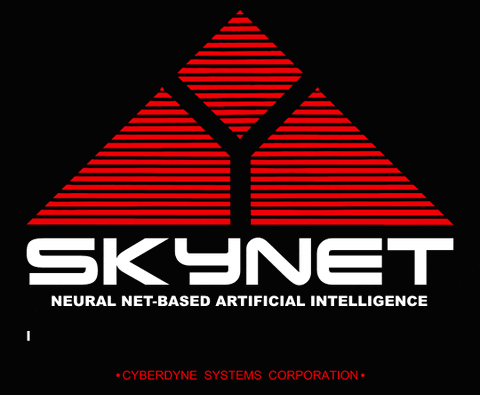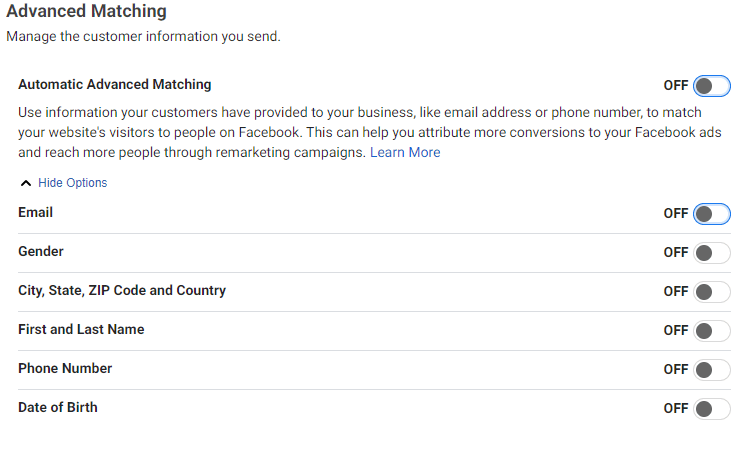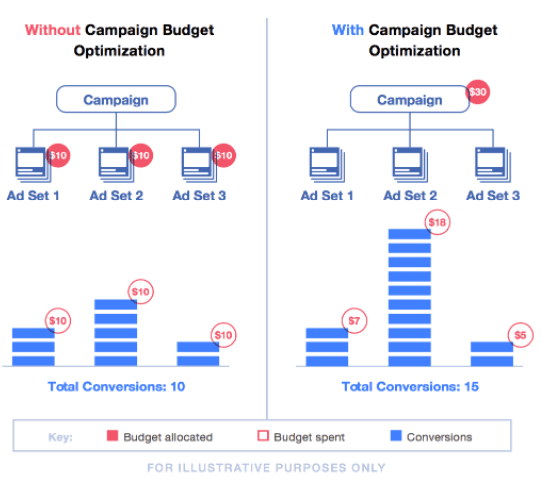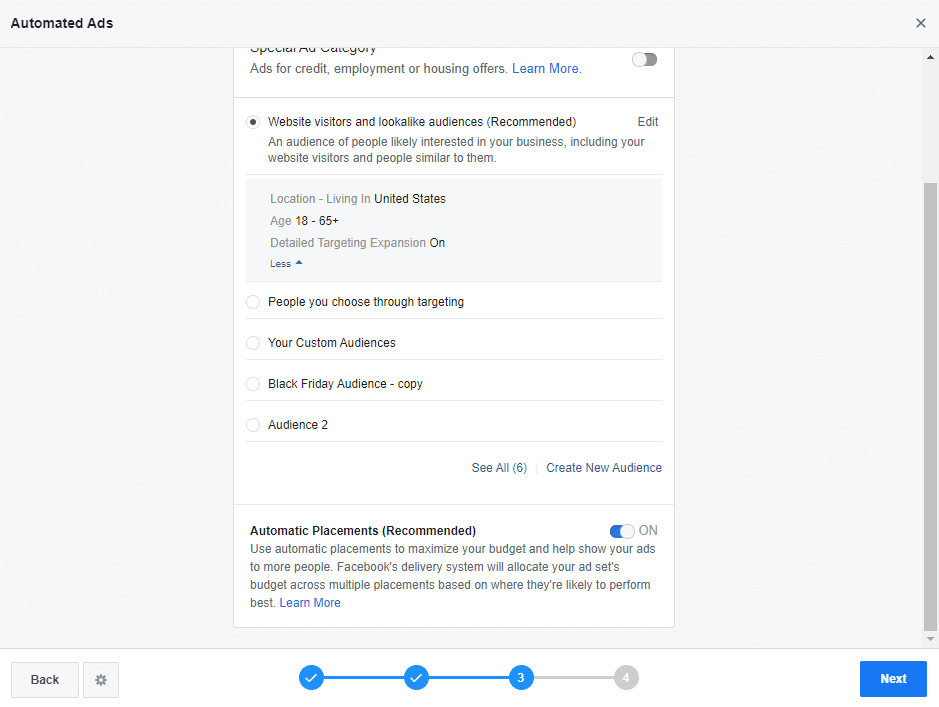Marketing on Facebook can demand a lot of time, money, and effort. Even after you’ve launched a campaign, there’s seemingly endless tinkering involved to ensure that it reaches your target audience and gets them to convert. This can feel like a lot of trial and error, often with mixed results.
Fortunately, Facebook provides guidelines that can supercharge your ad campaigns – if you know how to use them. The Facebook Power 5 can end your days of constant campaign monitoring, with a little help from Artificial Intelligence (AI).
In this post, I’ll introduce you to the Facebook Power 5 and talk about why they’re worth using. Then we’ll take a close look at each tactic, so you’ll be ready for your next big campaign. Let’s get started!
Introducing the Facebook Power 5
The Facebook Power 5 is a set of automated marketing tactics that use machine learning to provide the best possible results for your campaigns. It’s true: the machines are taking over, but at least they can make us some money first.

The tools that make up the Power 5 are:
- Auto advanced matching
- Simplified account structure
- Campaign budget optimization
- Automatic placements
- Dynamic ads
You can add any one of these tactics to your strategy, and you’ll likely see some results. However, the Power 5 work best when used together. The combination enables Facebook to learn about your customers and optimize your campaigns for maximum efficacy.
These tactics are designed to work on Facebook itself, obviously, but they are actually deployed across all of Facebook’s apps and services too. This includes Instagram, WhatsApp, Messenger, and Audience Network.
Why Use the Facebook Power 5 in Your Marketing Campaigns
Plenty of businesses have improved their marketing outcomes by implementing the Facebook Power 5. To prove the point, Facebook offers a number of case studies from a diverse range of organizations. We’ll look at a few highlights here.
First up, Smallwoods, a Texas-based home decor and textile retailer, had a goal to increase its revenue. By making use of dynamic ads, the company was able to find new customers who were likely to be interested in its products.
Smallwoods also used this tactic for retargeting website visitors who hadn’t yet made a purchase. The result was a 27x increase in purchases when compared to the previous year.
Using the Power 5 can also lower marketing costs, as in the case of Jambu. This company makes outdoor-inspired shoes that are both attractive and comfortable, and it sought to keep costs low while also acquiring new customers.
Jambu employed dynamic ads, while also taking advantage of automatic placements. This resulted in Facebook choosing which ads would appear, to whom, and on which platforms. Implementing these tactics let Jambu enjoy a 5.6x lower cost per acquisition than had been seen in previous campaigns.
Last but not least, Icelandair saw improved ad performance through its use of campaign budget optimization. This international airline had a goal of increasing flight searches from website visitors in the Cleveland area.
The campaign targeted Clevelanders, and ran on multiple platforms. Rather than readjusting ad spend allocation on the fly, Icelandair opted to use campaign budget optimization, which automatically adjusts spending. When compared to manual bidding, Icelandair saw a 74% increase in flight searches.
These are only a few examples, of course – and you could be the next one! The best thing about running a highly-optimized Facebook campaign is that it’s fast. It’s not like waiting around for a Search Engine Optimization (SEO) campaign to slowly take effect; you can start receiving new clicks and conversions right away.
Everything You Need to Know About the Facebook Power 5
Now that you’ve seen what the Facebook Power 5 are and what they can do in combination, let’s look at these tactics individually.
1. Auto Advanced Matching
If you have an e-commerce site, you probably already have the Facebook pixel installed. Auto advanced matching tells your pixel to look for and collect specific information about visitors on your site. This information can include their email addresses, phone numbers, locations, dates of birth, and more.
Gathering these details can result in better identity matching, which should enable you to attribute more conversions. This just means you’ll have a clearer picture of which conversions on your site are from Facebook. You can use that information to build a larger, more accurate custom audience.
The more you know about your audience, the more deeply you can understand which ads they respond to, and optimize those ads for maximizing conversions. Over time, your campaigns may actually become much more efficient, which can result in a lower cost per conversion.
The best news is that you don’t need to be able to code to enable auto advanced matching. Simply toggle it on in the Events Manager, and you’re ready to go:

Keep in mind that auto advanced matching pulls customer data from forms. So you should be getting a decent amount of information from the checkout process. However, don’t forget about newsletter signups, lead magnet downloads, and account creation forms.
If you use an IMG pixel or if it’s set up in an iframe, you won’t be able to use auto advanced matching. However, you can set up manual Advanced Matching instead. You may want to enlist a developer for help with this task, though, as it involves editing your pixel code.
2. Account Simplification
Right now, you might have dozens of audiences segmented out, and run separate campaigns targeting each of them. Not only is this an organizational nightmare, but it may not be as helpful as you think.
If data is what you’re after, this isn’t the best way to go about gathering it. Any information you receive from these campaigns is likely to be so spread out that it’s no longer statistically meaningful.
By simplifying your account structure, you make it possible for Facebook’s AI to extract meaningful data it can use to optimize your campaign. The AI tests your ads in real-time, and uses its findings to update them. Having fewer ad sets and campaigns makes it possible for the machine to work (and get you results) faster.
Also, you’ll no longer have to create multiple ad sets for your many audiences. This will likely help you avoid duplicates and overlaps, which can trap you into making separate ads that compete for the same audience.
Account simplification is a chore you may want to tackle before implementing the rest of the Power 5. For example, Smallwoods chose to clean house by reducing its number of ad sets before using automatic placements or dynamic ads.
Exactly how you simplify your account structure is ultimately up to you. However, an excellent place to start may be with your audience segments. If your current strategy is to niche down by age, zip code, shoe size, and favorite Beatle, you might try loosening your focus a bit.
Instead, create a bucket for people who have bought from you before, one for site visitors who have never purchased, and another for those who are unlikely to have heard of you at all, but would probably be interested in your product. A more straightforward structure like this should make it easier for the AI to study and act on your data.
Depending on how complicated your current account setup is, you may want to call in some professional help to get it sorted out. Fortunately, the Facebook marketing team is always happy to lend a hand with simplification efforts.
3. Campaign Budget Optimization
Managing the budget for campaigns with multiple ad sets can require a lot of time and attention. With Campaign Budget Optimization, the machine will allocate more of your budget to top-performing ads, making changes in real time:

You’ll no longer have to continually check the performance of your ads and make tweaks. This is easily automated thanks to machine learning. The result should be time saved for you, and better-performing campaigns.
So, what sort of complex statistical model do you need to build in order to harness the power of budget optimization? All you need to do is set a budget. The difference is that you’ll set this budget at the campaign level, rather than for individual ad sets.
After that point, the AI takes over, distributing more of your budget to the highest-performing ads. Judging by the results seen by Icelandair, the machine knows what it’s doing.
If the thought of handing over the reins entirely makes your skin crawl, rest assured that you still have plenty of control over your campaign. You can choose the delivery optimization for each ad set, as well as set bid caps and spending limits.
4. Automatic Placements
Along with managing a budget for multiple ad sets, you likely spend a lot of energy determining the best placements. Through Automatic Placements, Facebook will decide which placements are best for your ads.
Automatic placements work on a single ad set, displaying those ads across relevant platforms. Fourteen different placements are possible, including spots within feeds, contextual spaces, and even videos. Of course, the specific placements available to you may vary depending on your campaign objective.
The AI will allocate your budget to get you the most conversions for the least amount of money. This, along with the wide variety of possible placements, enables you to reach a bigger audience for a lower overall cost. Of course this saves money, but you’ll also save time since you won’t have to deal with segmenting by platform anymore.
As we saw earlier, Jambu made automatic placements a part of its Facebook marketing strategy. Not only did the company lower its acquisition costs, but it also saw a notably higher return on ad spend.
Automatic Placements is another easy tool to implement. It’s turned on at the ad set level, so you can simply toggle the option on when you’re creating your ad:

If you’ve been using asset customization for placements, that will continue to work with automatic placements too. You won’t have to worry about creating an ad set for every possibility.
5. Dynamic Ads
Imagine that you had the resources to create a personalized ad for every one of your potential customers. This ad would be for exactly the right product, and show up at precisely the right place. That’s the basic idea behind dynamic ads.
Dynamic ads work in a couple of ways. First, they promote items to people who are likely to be interested in your product, based on the fact that they’ve browsed your site or app in the past but haven’t made a purchase. These retargeting ads display across all of Facebook’s apps.
Facebook can also show your products to people who haven’t looked at your offerings specifically, but have shown interest in similar products. This is determined by looking at users’ clicks, likes, and browsing history, resulting in highly-personalized ads. These laser-focused ads are part of what helped Smallwoods and Jambu reach their business goals.
You will need some sort of catalog to take advantage of dynamic ads. Getting started is as simple as uploading that catalog.
What’s more, you don’t have to create individual ads for each product with this tool. Instead, you’ll build an ad template using a single image, collection, or carousel. You can also add overlays, offers, and whatever copy you’d like.
Conclusion
Having the time to concentrate on long-term strategy and be creative may seem like an impossible dream when you’re mired in A/B testing. However, by utilizing Facebook’s Power 5, you should be able to focus on what you’re best at and leave the tinkering to the machines.
Let’s recap the Facebook Power 5:
- Auto advanced matching: Gain more in-depth insights into your audience through the Facebook pixel.
- Account simplification: Reorganize your account structure to help the AI work faster and better.
- Campaign budget optimization: Stop spending valuable time making tweaks to your ad spend.
- Automatic placements: Allocate campaign budget toward the highest performing ad placements.
- Dynamic ads: Promote your products to the audiences that are most likely to buy.
Do you still have questions about how to make the most of your paid advertising? Ask us in the comments section below!